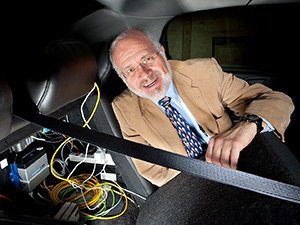Max Donath: From Distraction to Coach

Car wrecks kill more U.S. teens aged 15–19 than any other cause, according to the Centers for Disease Control and Prevention. Additionally, drivers under age 20 are nearly four times as likely to have a crash than older drivers.
What are among the causes? Using a cell phone distracts them. A mobile phone was involved 19 percent of the time teen drivers caused a fatal accident.
An app developed by a team of researchers led by Max Donath, mechanical engineering professor and director of the University Intelligent Transportation Systems Institute, has transformed this potential distraction into a tool to coach and monitor teen drivers and alert their parents to driving problems.
The app gives feedback to drivers if they jam on the brakes, roll through stop signs, or exceed the speed limit. It even alerts drivers to upcoming curves. Data from the drive is stored online so parents can review their teen’s driving performance.
The smartphone app became DriveScribe. The University licensed the technology to the startup company Drive Power, which is marketing the product both to parents of young drivers and managers of corporate fleets.
Work on the project began several years ago, Donath explained. The first prototype, tested in 2006, used a laptop in the car and a separate GPS unit to track the vehicle’s location. “It was certainly not anything that a teenager would want or care to use,” Donath said.
Later efforts used smartphone platforms. In the most recent version, Alec Gorjestani, Michael Manser, and Janet Creaser, researchers in the Department of Mechanical Engineering, worked to develop the kinds of warning and coaching that kids might best respond to.
"We are constantly working on new ideas and testing them."— Max Donath
“We spent a lot of time figuring out what words to use,” Donath said. “We do use a whole host of expressions to tell the teen to slow down, and if the teen doesn’t pay any attention, we warn them that we’ll tell their parents where they are. If they continue to ignore us, we text message the parents where they are and that they’re speeding.”
At the same time, the app blocks calls, email, and texts. “It’s basically taking over the phone,” Donath said.
Donath’s team tested the device with 30 teenage drivers and their parents on the roads around Stillwater. Washington County is among the counties in the state with the highest number of teenage driver fatalities. A researcher rode along with the teen drivers while the parents waited behind. “The idea was to see how the teen reacted to the system, what their impressions were, and how their parents felt about it,” Donath said.
The software project was funded by the Intelligent Transportation Systems Institute, a University transportation center affiliated with the Center for Transportation Studies, with money from the U.S. Department of Transportation and the Minnesota Department of Transportation. After Drive Power licensed the new app, Gorjestani became vice president of technology of the new company.
Donath, however, is happy keeping the new company and the evolving DriveScribe app at arm’s length.
“To be perfectly honest with you, it is not my philosophy for me to leave the University to start a company,” Donath said. Instead, he says he sees himself and the University as a tech incubator.
“We are constantly working on new ideas, and testing them,” said Donath. “The bottom line is that we want to see this technology get out there. But before it can get out there, we have to evaluate these ideas and try them out. So as a research organization, our focus has for a long time been on trying out new ideas, evaluating them, getting feedback, seeing if they really resonate with the users. If they do, we want to see them deployed.”
